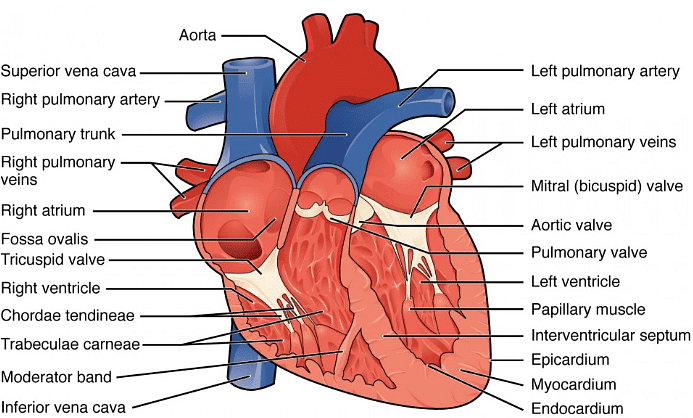Class 10 Exam > Class 10 Notes > Biology for GCSE/IGCSE > Identifying Structures in the Heart
Identifying Structures in the Heart | Biology for GCSE/IGCSE - Class 10 PDF Download
Identifying Structures in the Heart: Extended
- The ventricles possess thicker muscular walls compared to the atria because they are responsible for pumping blood out of the heart, necessitating the generation of higher pressure.
- Specifically, the left ventricle exhibits a thicker muscular wall than the right ventricle because it must propel blood at high pressure throughout the entire body, while the right ventricle pumps blood at lower pressure to the lungs.
- Acting as a partition, the septum divides the heart into two sides, thereby preventing the mixing of oxygenated and deoxygenated blood.
Structure of the Heart Valves

The function of valves
- Valves serve the fundamental purpose of preventing the backward flow of blood.
- The heart comprises two sets of valves:
- Atrioventricular valves, which separate the atria from the ventricles.
- The tricuspid valve on the right side and the bicuspid (or mitral) valve on the left side regulate blood flow between the atria and ventricles.
- These valves open when the atria contract, allowing blood passage, but close when the ventricles contract to prevent backflow into the atria.
- Semilunar valves are situated in the two major arteries originating from the heart.
- Unique to these arteries, semilunar valves facilitate one-way blood flow, preventing backflow.
- These valves open during ventricular contraction to permit blood ejection from the heart but close thereafter to prevent blood from re-entering the heart.
Question for Identifying Structures in the HeartTry yourself: Why do the ventricles have thicker muscular walls compared to the atria?View Solution
The document Identifying Structures in the Heart | Biology for GCSE/IGCSE - Class 10 is a part of the Class 10 Course Biology for GCSE/IGCSE.
All you need of Class 10 at this link: Class 10
|
110 videos|210 docs|33 tests
|
FAQs on Identifying Structures in the Heart - Biology for GCSE/IGCSE - Class 10
1. What are the main structures in the heart that are responsible for the pumping action?$#
Ans. The main structures in the heart responsible for the pumping action are the four chambers (two atria and two ventricles) and the valves (tricuspid, mitral, pulmonary, and aortic valves).
2. How do the atria and ventricles work together to pump blood effectively through the heart?$#
Ans. The atria receive blood from the body and lungs, then contract to push blood into the ventricles. The ventricles then contract to pump blood out of the heart to the lungs and the rest of the body.
3. What is the role of the valves in the heart and how do they prevent backflow of blood?$#
Ans. The valves in the heart ensure that blood flows in one direction by opening and closing at the right times during the cardiac cycle. They prevent backflow of blood by closing tightly when the ventricles contract.
4. Can you explain the function of the coronary arteries in the heart?$#
Ans. The coronary arteries supply oxygen-rich blood to the heart muscle itself. They ensure that the heart has enough blood and nutrients to function properly, especially during times of increased activity.
5. How does the electrical conduction system in the heart help regulate the heart's rhythm?$#
Ans. The electrical conduction system in the heart controls the timing and sequence of heart muscle contractions. It coordinates the chambers of the heart to contract in a specific order, ensuring an efficient pumping action.
Ans. The main structures in the heart responsible for the pumping action are the four chambers (two atria and two ventricles) and the valves (tricuspid, mitral, pulmonary, and aortic valves).
2. How do the atria and ventricles work together to pump blood effectively through the heart?$#
Ans. The atria receive blood from the body and lungs, then contract to push blood into the ventricles. The ventricles then contract to pump blood out of the heart to the lungs and the rest of the body.
3. What is the role of the valves in the heart and how do they prevent backflow of blood?$#
Ans. The valves in the heart ensure that blood flows in one direction by opening and closing at the right times during the cardiac cycle. They prevent backflow of blood by closing tightly when the ventricles contract.
4. Can you explain the function of the coronary arteries in the heart?$#
Ans. The coronary arteries supply oxygen-rich blood to the heart muscle itself. They ensure that the heart has enough blood and nutrients to function properly, especially during times of increased activity.
5. How does the electrical conduction system in the heart help regulate the heart's rhythm?$#
Ans. The electrical conduction system in the heart controls the timing and sequence of heart muscle contractions. It coordinates the chambers of the heart to contract in a specific order, ensuring an efficient pumping action.
Related Searches















